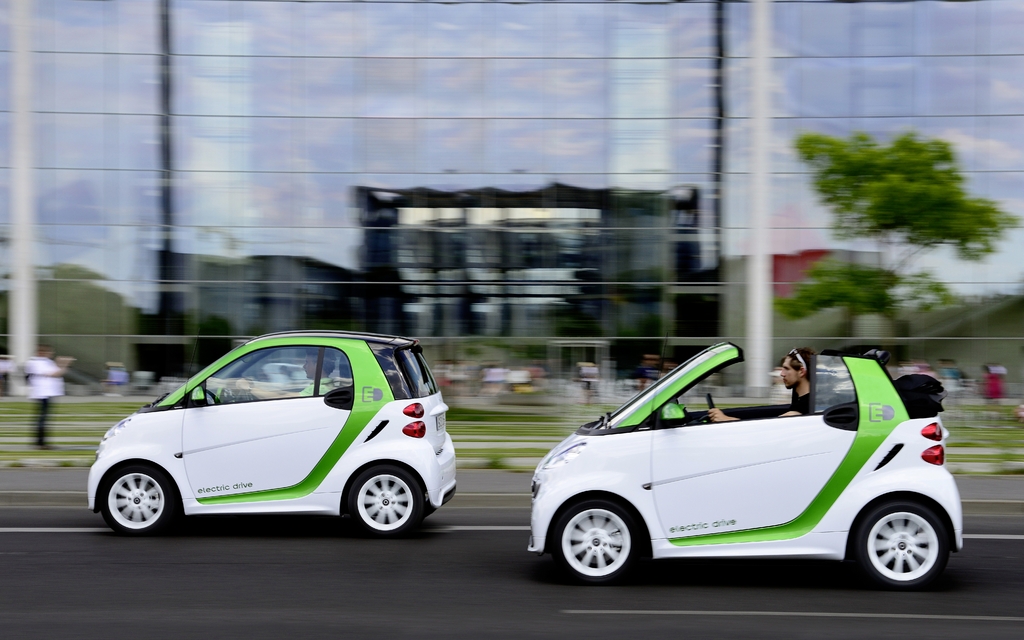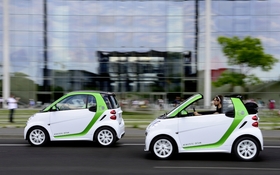2013 smart electric: The 3rd generation
The third generation smart electric drive will be marketed in Canada as of summer 2013. Priced at $26,990, the coupe will become the least expensive electric car available in our country. But the smart line-up doesn’t stop there: there’s a cabriolet too, offering a zero-emission ride under the open sky for $29,900. Note that both versions qualify for the $8,000 rebate from the Quebec government. And coming soon to a smart dealer near you: the electric-assist smart ebike, which will hit the market in summer 2012 at a price of $3,240. During the official launch of these models in Berlin, I had the chance to drive the third generation smart electric drive and to ride the smart ebike electric bicycle. It was an electrifying experience, to say the least.
New motor and battery
To perfect the new smart electric drive, the brand’s engineers replaced the engine and battery seen in the second generation. Thus, a new electric motor, jointly developed by Daimler and Bosch, delivers 35 to 55 kilowatts (46 to 73 horses) of power and 130 Newton metres (about 95.8 lbs-ft) of torque, while the previous motor only produced 20 to 30 kilowatts. What’s more, a 17.6-kilowatts/hour lithium-ion battery was developed by Daimler and Evonik to replace the one made by Tesla. This new battery helps increase driving range from 135 to 145 kilometres while decreasing recharging time from 8 hours to 7 on a 220-volt current. The new smart electric drive can reach a maximum speed of 125 kilometres per hour – a fact that I confirmed on the Autobahn – while the second generation model topped out at 100 kilometres per hour.
- Also: 2014 smart electric drive: Worry, Wait and Guilt
- Also: Japan Will Get a Smart Fortwo EV Disney Edition
On the road
Behind the wheel of the third-gen smart electric drive, you can go from 0 to 60 kilometres/hour in 4.8 seconds and from 0 to 100 kilometres/hour in 11.5 seconds, meaning that its performance compares to that of certain sub-compacts. During my test drive, I quickly noted that the new smart electric had no problem circulating in the streets of Berlin, and any memories of the lethargic and powerless second generation were promptly forgotten. With the new smart electric drive, getting onto the highway was easy and its maximum speed of 125 kilometres per hour meant I never felt as though I was holding back the cars behind me – plus I never had to worry about keeping up with the flow of traffic.
Even the braking has been improved. The energy recovery system engages much more progressively as it occurs in three stages. Firstly, the simple act of releasing the accelerator makes the vehicle decelerate because of the kinetic energy recovery. Secondly, as the electric motor is mostly responsible for braking, the act of braking itself increases energy recovery. Thirdly, the conventional hydraulic brakes spring into action to complete the deceleration and bring the vehicle to a complete stop. In a city like Berlin where there is amply public infrastructure for recharging, driving a smart electric drive is now quite a feasible option. Unfortunately, that’s not the case in Canada yet.
What about when it’s minus-twenty degrees?
During a long conversation with Jochen Eck, head of the testing and performance assessment program for electric vehicles, I learned that the 145-km driving range applies to ideal conditions and could drop to 90 kilometres in winter conditions, such as those encountered during winter testing in Sweden when the mercury sunk to -20 degrees Celsius. He also specified that it wasn’t a good idea to leave the vehicle parked outside without plugging it in when the temperature was -20 degrees. The battery can drop to just 20% and the vehicle’s performance can suffer. But he also specified that as long as the battery has more than a 50% charge, you won’t have any problems driving the vehicle, even in those conditions. According to the engineers who developed it, the third generation smart electric drive’s battery should have a lifespan of 10 years.
To help smart electric drive buyers better “communicate” with their vehicle, there’s an iPhone application. It lets users remotely control recharging the battery, monitor recharging progress in real time and even receive a message via Twitter when the battery is fully charged. This application also helps the user preheat or pre-air-condition the passenger compartment – provided the vehicle is plugged in – by using the energy from the current supplying the battery. That means you’ll be able to get into a comfortable passenger compartment even before you start the car, without drawing on the battery.
In Europe, customers who buy or long-term lease the smart electric drive can pay just 65 euros a month for the Sale and Care program, which covers all maintenance costs, including the cost of battery replacement in case of a decline in its performance. Note that this program will not be offered in Canada, but that the unofficial cost of battery replacement is estimated at $4,000 or $5,000. Do the math: 65 euros a month for 10 years is 7,800 euros, or almost the price of two batteries. Although the battery will have to be replaced after five or six years, Canadian buyers still win since they won’t be paying the monthly program fees.
What about the bicycle?
The smart ebike is a hybrid bicycle called Pedelec (Pedal Electric Cycle) on which the user absolutely must pedal to make it go: the electric motor is only there to assist you, and it ceases to help once you reach 25 kilometres per hour. This is because of a European rule that stipulates that neither a license plate nor driver’s license is necessary for a Pedelec. All of that means that the smart ebike is very different from certain electric bicycles available in Canada, such as the California-built A2B, where the electric motor can propel the bike without the help of the rider.
The smart ebike’s battery has a capacity of 423 watts per hour and up to 100 kilometres of range, depending on the conditions. Also note that by engaging the front brake, the rider automatically commands the kinetic energy recovery, just like on an electric car, and that the smart ebike is equipped with a factory standard USB to supply power to the electric accessories. Plus, a “cradle” allows you to attach a smart phone for use as a navigation system. Finally, smart’s brass confirmed its intention to market an electric scooter in 2013 in order to complete its line-up of zero emission vehicles.












